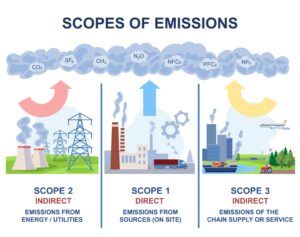What is the Greenhouse Gas (GHG) Protocol?
- CO2-reduction

In today’s era of increasing environmental awareness, businesses and organizations are turning to tools that measure and manage their environmental impact. The GHG Protocol, short for Greenhouse Gas Protocol, is an international standard that establishes procedures for calculating and reporting GHG emissions.
If you’re interested in the purpose of the Green Gas Protocol, how it works or how to calculate GHG emissions in each category of Scope 1, 2, and 3, please read for the full details on this page.
Key Takeaways:
- The GHG Protocol is a standard for emission reporting: It provides a comprehensive, global framework for measuring and managing greenhouse gas emissions.
- Scope 1, 2, and 3 emissions: The protocol categorizes emissions into three scopes, allowing for a detailed understanding and accounting of direct and indirect emissions.
- Worldwide: The GHG Protocol is widely used by governments, businesses, and other organizations worldwide for emission reporting and reduction strategies.
Table of Contents
- 1 What is the Greenhouse Gas (GHG) Protocol?
- 2 Understanding What Greenhouse Gas Emissions Are
- 3 Why is the GHG Protocol important for companies?
- 4 How to calculate GHG Protocol supply chain emissions
- 5 What is the role of GHG protocol in policy making?
- 6 FAQ about GHG Protocol
- 7 Recap of GHG Protocol importance
What is the Greenhouse Gas (GHG) Protocol?
The Greenhouse Gas(GHG) Protocol is a globally recognized framework for accounting and reporting greenhouse gas emissions. It provides a standardized method for companies to measure and manage their carbon footprint, fostering transparency and accountability.
The GHG Protocol was developed by the World Resources Institute (WRI) and the World Business Council for Sustainable Development (WBCSD), and it has been introduced to standardize emissions accounting.
Its purpose extends beyond compliance, aiming to drive businesses toward sustainable practices voluntarily.
Understanding What Greenhouse Gas Emissions Are
Greenhouse gasses come in various forms, each contributing differently to the greenhouse effect. Understanding all kinds of gasses like carbon dioxide, methane, and nitrous oxide is crucial for effective emissions management.
Three Scopes of Emissions

There are three different standards to identify GHG, Scope 1, Scope 2, and Scope 3. Companies need to specify which scope they refer in their reports.
Scope 1: direct greenhouse gas emissions
Scope 1 emissions encompass direct greenhouse gas emissions produced by an organization. This includes emissions from owned or controlled sources such as vehicles, equipment, and facilities.
Scope 2: indirect emissions
Scope 2 emissions involve indirect emissions generated from the production of purchased energy. This includes emissions from electricity, heat, or steam purchased by an organization.
Scope 3: encompasses the entire value chain.
Scope 3 emissions are indirect emissions that occur in the organization’s value chain, including both upstream and downstream activities. This involves everything from supply chain operations to product use and disposal.
Why is the GHG Protocol important for companies?
Comprehensive emission management
GHG Protocol provides a structured and comprehensive framework for companies to manage their greenhouse gas emissions. It goes beyond merely measuring direct emissions (Scope 1) and includes both indirect emissions from purchased energy (Scope 2) and those within the value chain (Scope 3).
This holistic approach ensures a thorough understanding of the organization’s entire carbon footprint.
Appeal in environmental protection activities
Companies adopting GHG Protocol demonstrate a commitment to environmental stewardship.
By actively measuring, managing, and reducing their emissions, organizations contribute to global efforts to combat climate change.
This commitment not only aligns with ethical business practices but also resonates positively with environmentally conscious consumers and investors.
Regulatory compliance
As governments worldwide intensify their focus on environmental regulations, adherence to emission reporting standards becomes crucial. GHG Protocol aids companies in staying compliant with regulatory requirements related to greenhouse gas emissions.
This proactive approach not only mitigates legal risks but also positions the company as a responsible corporate citizen.
Corporate Social Responsibility (CSR)
GHG Protocol plays a vital role in enhancing a company’s Corporate Social Responsibility (CSR) profile. Proactively addressing environmental impact demonstrates a commitment beyond profit, fostering a positive corporate image.
This can lead to increased trust among customers, partners, and the broader community.
Cost savings through efficiency
The GHG Protocol encourages companies to assess their energy consumption and emissions. This process often reveals opportunities for cost savings through increased energy efficiency and optimized resource use.
By identifying and implementing measures to reduce emissions, organizations not only benefit the environment but also realize financial savings.
How to calculate GHG Protocol supply chain emissions
Calculating supply chain emissions within the framework of the Greenhouse Gas Protocol (GHG Protocol) involves a systematic process.
The following steps outline the flow of how organizations can measure and manage emissions associated with their supply chain.
1. Identify and categorize emission sources
Enumerate all potential emission sources within the supply chain. A thorough identification of sources ensures a comprehensive assessment.
Then, classify emission sources into relevant GHG Protocol scopes. Scope 1 includes direct emissions from owned or controlled sources, such as company-owned vehicles. Scope 2 involves indirect emissions from purchased energy, while Scope 3 encompasses indirect emissions in the value chain.
2. Apply and calculate emission factors
Utilize emission factors to convert raw data into greenhouse gas emissions. Emission factors are standardized coefficients that represent the amount of greenhouse gases emitted per unit of activity or consumption. These factors can vary based on the type of activity, fuel, or material used.
Next, apply the gathered data and emission factors to calculate emissions for each scope. The GHG Protocol provides specific calculation methodologies for each scope, ensuring consistency and comparability of results. The calculation should consider CO2 equivalent (CO2e) values to account for the different global warming potentials of various greenhouse gases.
3. Address data gaps
Identify and address any data gaps or uncertainties in the emission calculations. This may involve making reasonable assumptions or seeking additional information from suppliers. Transparency and diligence in handling data gaps enhance the credibility of the emission assessment.
Identifying emission hotspots within the supply chain is also an important step. Those are areas with large emissions on the overall carbon footprint. This information is valuable for prioritizing mitigation efforts and implementing targeted sustainability measures.
4. Set reduction targets
Based on the calculated emissions and hotspot analysis, set realistic and achievable reduction targets. Establishing clear targets enables organizations to track progress over time and demonstrates a commitment to continuous improvement in supply chain sustainability.
By following this GHG Protocol Supply Chain Emissions Calculation Flow, organizations can gain a comprehensive understanding of their supply chain emissions, identify opportunities for improvement, and contribute to a more sustainable and environmentally responsible business model.
What is the role of GHG protocol in policy making?
Influence on environmental policies:The GHG Protocol’s influence extends beyond individual companies. Its adoption has shaped environmental policies, prompting governments to consider similar standards for broader regulatory frameworks.
Regulatory compliance and reporting:As governments worldwide focus on environmental regulations, companies adhering to the GHG Protocol find themselves better positioned for compliance. Transparent reporting aids in navigating evolving regulatory landscapes.
FAQ about GHG Protocol
Is GHG Protocol compliance mandatory?
GHG Protocol compliance is not mandatory.
However, it is highly encouraged for organizations seeking to enhance their environmental responsibility and align with global sustainability standards.
How often should organizations measure their emissions using GHG Protocol?
Organizations commonly conduct annual assessments of their greenhouse gas emissions. The frequency may vary based on business operations, but regular measurement is essential for tracking progress and identifying areas for improvement.
What role does GHG Protocol play in achieving sustainability goals?
GHG Protocol is a key tool in achieving sustainability goals by providing a structured framework for organizations to understand and manage their environmental impact. It allows companies to set reduction targets and track progress over time.
Recap of GHG Protocol importance
The GHG Protocol plays a pivotal role in guiding businesses toward environmental responsibility. Its global recognition, comprehensive standards, and positive impact on industries make it an indispensable tool for companies committed to sustainability.
As we navigate the complexities of climate change, encouraging further adoption of the GHG Protocol is crucial. By fostering a culture of environmental responsibility, businesses can collectively contribute to a healthier planet.
You May Also Interested in:
Understanding J-Credit: How It Works, Pros and Cons, and Ways to Buy.
What dose carbon budget mean and how it help us to achieve net zero emissions?
A guide of Carbon Neutrality – What is the Difference between Net Zero and Decarbonization?
What Does It Mean To Be Carbon Negative? Difference Between Carbon Positive and Carbon Neutrality
CONTACT US
Please feel free to contact us at anytime.
We will get back to you as soon as we
can!
Editor
OFFSEL Owned by Erevista Inc, OFFSEL is specializes in Environmental issues, especially in carbon neutrality. We primarily provide the latest information on environmental energy.




